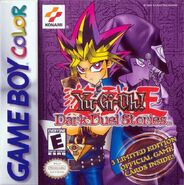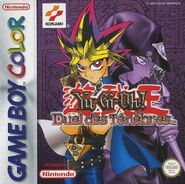Cheesedude (talk | contribs) (+trailer from Wikia's video library.) |
AkulakhanBot (talk | contribs) |
||
| (31 intermediate revisions by 15 users not shown) | |||
| Line 1: | Line 1: | ||
| + | {{about|the internationally released game|the Japan-exclusive game|Yu-Gi-Oh! Duel Monsters II: Dark duel Stories}} |
||
{{VGInfobox |
{{VGInfobox |
||
| image name = DDS-VideoGameEN.jpg |
| image name = DDS-VideoGameEN.jpg |
||
| image size = |
| image size = |
||
| english name = Yu-Gi-Oh! Dark Duel Stories |
| english name = Yu-Gi-Oh! Dark Duel Stories |
||
| − | | kanji name = 遊戯王デュエルモンスターズ |
+ | | kanji name = 遊戯王デュエルモンスターズIII {{Ruby|三聖戦神降臨|トライホーリーゴッドアドバント}} |
| − | | romaji name = |
+ | | romaji name = Yūgiō Dyueru Monsutāzu III Toraihōrīgoddo Adobanto |
| japanese translated name = Yu-Gi-Oh! Duel Monsters III: Tri-Holy God Advent |
| japanese translated name = Yu-Gi-Oh! Duel Monsters III: Tri-Holy God Advent |
||
| developer = Konami |
| developer = Konami |
||
| Line 11: | Line 12: | ||
| rating = |
| rating = |
||
| genre = Card Battle |
| genre = Card Battle |
||
| − | | release date = |
+ | | release date = |
| + | * {{flag|Japan}} July 13, 2000 |
||
| + | * {{flag|United States}} March 19, 2002 |
||
}} |
}} |
||
| − | '''''Yu-Gi-Oh! Duel Monsters III: Tri-Holy God Advent''''' (遊戯王デュエルモンスターズ |
+ | '''''Yu-Gi-Oh! Dark Duel Stories''''', released in Japan as '''''Yu-Gi-Oh! Duel Monsters III: Tri-Holy God Advent''''' (遊戯王デュエルモンスターズIII {{Ruby|三聖戦神降臨|トライホーリーゴッドアドバント}} ''Yūgiō Dyueru Monsutāzu III Toraihōrīgoddo Adobanto''), is a [[wikipedia:Game Boy Color|Game Boy Color]] video game and the third title in the ''[[Yu-Gi-Oh! Duel Monsters (video game series)|Yu-Gi-Oh! Duel Monsters]]'' series of games. It was released in Japan on July 13, [[2000]], and it was the first ''Yu-Gi-Oh!'' video game to be released outside of Japan, with a United States release date of March 19, [[2002]]. |
Players of the game can trade and battle with other players using a [[wikipedia:Game Link Cable|link cable]]. |
Players of the game can trade and battle with other players using a [[wikipedia:Game Link Cable|link cable]]. |
||
==Duels== |
==Duels== |
||
| − | Players must beat each player in a stage |
+ | Players must beat each player in a stage five times, in order to get to the next stage. Once the player beats a character five times, he or she may continue to duel them for more points [see ''Passwords & More'']. Here are the list of characters that a player may duel against: |
| + | {| class=wikitable |
||
| ⚫ | |||
| + | ! Opponents |
||
| ⚫ | |||
| + | |- |
||
| + | ! colspan="2" | Stage 1 - Domino City |
||
| + | |- |
||
| + | | |
||
# [[Tristan Taylor]] (''Hiroto Honda'') |
# [[Tristan Taylor]] (''Hiroto Honda'') |
||
# [[Joey Wheeler]] (''Katsuya Jonouchi'') |
# [[Joey Wheeler]] (''Katsuya Jonouchi'') |
||
| Line 27: | Line 36: | ||
# [[Mako Tsunami]] (''Ryouta Kajiki'') |
# [[Mako Tsunami]] (''Ryouta Kajiki'') |
||
# [[Yugi Muto]] (''Yugi Mutou'') |
# [[Yugi Muto]] (''Yugi Mutou'') |
||
| + | | [[File:DM3 ST1.png|Stage 1]] |
||
| − | |||
| + | |- |
||
| ⚫ | |||
| + | ! colspan="2" | Stage 2 - Domino City |
||
| + | |- |
||
| + | | |
||
# [[Espa Roba]] (''Esper Roba'') |
# [[Espa Roba]] (''Esper Roba'') |
||
# [[Rex Raptor]] (''Dinosaur Ryuzaki'') |
# [[Rex Raptor]] (''Dinosaur Ryuzaki'') |
||
# [[Weevil Underwood]] (''Insector Haga'') |
# [[Weevil Underwood]] (''Insector Haga'') |
||
| − | # [[Seeker]] (''Rare Hunter'') |
+ | # [[Rare Hunter (character)|Seeker]] (''Rare Hunter'') |
# [[Arkana|Pandora]] (''Arkana'') |
# [[Arkana|Pandora]] (''Arkana'') |
||
# [[Seto Kaiba]] |
# [[Seto Kaiba]] |
||
| + | | [[File:DM3 ST2.png|Stage 2]] |
||
| − | |||
| + | |- |
||
| − | ===Stage 3=== |
||
| + | ! colspan="2" | Stage 3 - Ancient Egypt |
||
| + | |- |
||
| + | | |
||
# [[Simon Muran|Paradox]] (''Simon Muran'') |
# [[Simon Muran|Paradox]] (''Simon Muran'') |
||
# [[Priest Seto|P. Seto]] (''[[Priest Seto]]'') |
# [[Priest Seto|P. Seto]] (''[[Priest Seto]]'') |
||
# [[Ishizu Ishtar]] (''[[Isis Ishtar]]'') |
# [[Ishizu Ishtar]] (''[[Isis Ishtar]]'') |
||
| − | # [[Heishin|Slysheen]] ( |
+ | # [[Heishin|Slysheen]] (known as ''[[Heishin]]'' in European releases) |
| + | | [[File:DM3 ST3.png|Stage 3]] |
||
| − | |||
| + | |- |
||
| − | ===Stage 4=== |
||
| + | ! colspan="2" | Stage 4 - DarkNite |
||
| − | |||
| + | |- |
||
| + | | |
||
# [[DarkNite]] |
# [[DarkNite]] |
||
| + | | [[File:DM3 ST4.png|Stage 4]] |
||
| − | |||
| + | |- |
||
| − | ===Stage 5=== |
||
| + | ! colspan="2" | Stage 5 |
||
| − | |||
| + | |- |
||
| + | | |
||
# [[Yami Yugi]] (''Dark Yugi'') |
# [[Yami Yugi]] (''Dark Yugi'') |
||
# [[Marik Ishtar]] (password required) |
# [[Marik Ishtar]] (password required) |
||
| Line 53: | Line 72: | ||
# [[Shadi]] (password required) |
# [[Shadi]] (password required) |
||
# [[Nitemare]] (password required) |
# [[Nitemare]] (password required) |
||
| + | |} |
||
| + | |||
| + | ==Starter Deck== |
||
| + | The player's Starter Deck consists of the following 40 cards:<ref>http://datacrystal.romhacking.net/wiki/Yu-Gi-Oh!_Dark_Duel_Stories:ROM_map#Starter_deck</ref> |
||
| + | {{Decklist |
||
| + | |normal monsters = |
||
| + | * [[Sinister Serpent]] x3 |
||
| + | * [[Milus Radiant]] |
||
| + | * [[Zone Eater]] |
||
| + | * [[Swordsman from a Foreign Land]] |
||
| + | * [[Fungi of the Musk]] |
||
| + | * [[Shadow Specter]] x3 |
||
| + | * [[Bone Mouse]] |
||
| + | * [[Kaminarikozou]] |
||
| + | * [[White Dolphin]] |
||
| + | * [[Wretched Ghost of the Attic]] x2 |
||
| + | * [[Turu-Purun]] x2 |
||
| + | * [[Jinzo 7|Jinzo #7]] |
||
| + | * [[Muka Muka]] |
||
| + | * [[Mech Mole Zombie]] |
||
| + | * [[Mechanical Spider]] |
||
| + | * [[Boo Koo]] |
||
| + | * [[Star Boy]] |
||
| + | * [[Abyss Flower]] |
||
| + | * [[Mystery Hand]] x3 |
||
| + | * [[Hiro's Shadow Scout]] x2 |
||
| + | * [[Air Marmot of Nefariousness]] |
||
| + | * [[Droll Bird]] |
||
| + | * [[Yamatano Dragon Scroll]] |
||
| + | * [[Bladefly]] |
||
| + | * [[Frog The Jam]] |
||
| + | * [[Gale Dogra]] |
||
| + | * [[Masked Clown]] |
||
| + | * [[Cyber-Stein]] |
||
| + | |effect monsters = |
||
| + | * [[Leghul]] x2 |
||
| + | * [[Monster Eye]] |
||
| + | }} |
||
==Format== |
==Format== |
||
| − | Dark Duel Stories does not totally conform to the rules of the [[OCG|Official Card Game]]. This includes many cards having different [[Card |
+ | Dark Duel Stories does not totally conform to the rules of the [[OCG|Official Card Game]]. This includes many cards having different [[Card effect|effects]], or having their effects removed altogether, including, but not limited to, [[Jirai Gumo]]; this means that some Monster cards with effects in the OCG may not have any effects at all in this game, whether positive or negative. Rather than having flip effects or passive effects like many cards in the OCG, most cards seem to only be able to activate their effects on the first turn they are played. Many cards seen only in this game (the 'Creatable' cards) also have Type and/or Attribute that do not match their appearance at all. While this can also be seen in the official card game, this happens much more often in this game. |
During gameplay there is more than one way to win. A player may win by decreasing the opponent's life points to zero, forcing your opponent to run out of cards (have them unable to draw a card at the start of their turn), or by having all five pieces of [[Exodia the Forbidden One|Exodia]] in your hand. |
During gameplay there is more than one way to win. A player may win by decreasing the opponent's life points to zero, forcing your opponent to run out of cards (have them unable to draw a card at the start of their turn), or by having all five pieces of [[Exodia the Forbidden One|Exodia]] in your hand. |
||
| Line 63: | Line 120: | ||
Here are some basic rules for playing: |
Here are some basic rules for playing: |
||
| − | * You may only have up to |
+ | * You may only have up to five [[Monster Card|monsters]] on the field. |
| − | * You may have up to five cards in your hand (Note: If you have five cards in hand at the start of your turn, you will not be able to draw a new card) |
+ | * You may have up to five cards in your hand (Note: If you have five cards in hand at the start of your turn, you will not be able to draw a new card). |
| − | * Each [[Monster Card]] may attack any opposition monster card on the field |
+ | * Each [[Monster Card]] may attack any opposition monster card on the field. |
| − | * Once the field is empty, you may attack the opposing duelist's Life Points |
+ | * Once the field is empty, you may attack the opposing duelist's Life Points. |
| − | * Each duelist starts with 8000 Life Points ([[Life Points]]) |
+ | * Each duelist starts with 8000 Life Points ([[LP|Life Points]]). |
| − | * In order to summon a 5-6 star Card, you must [[Tribute]] one monster that is already on the field |
+ | * In order to summon a 5-6 star Card, you must [[Tribute]] one monster that is already on the field. |
| − | * In order to summon a 7-8 star Card, you must [[Tribute]] two monsters that are already on the field |
+ | * In order to summon a 7-8 star Card, you must [[Tribute]] two monsters that are already on the field. |
* You may only summon one monster per turn. |
* You may only summon one monster per turn. |
||
| − | * You may also set one [[Trap Card]] on the field (Note: If the Trap is not used during the opponent's turn, it is removed at the start of your turn) |
+ | * You may also set one [[Trap Card]] on the field (Note: If the Trap is not used during the opponent's turn, it is removed at the start of your turn). |
==Battle types== |
==Battle types== |
||
| Line 79: | Line 136: | ||
The most basic way to defeat an opposing monster is to have a monster with higher attack |
The most basic way to defeat an opposing monster is to have a monster with higher attack |
||
| − | Example: Player A's card = 1000 [[ATK]], Player B's card = 1200 ATK. Player A's card is destroyed and loses 200 Life Points ([[Life Points]]) |
+ | Example: Player A's card = 1000 [[ATK]], Player B's card = 1200 ATK. Player A's card is destroyed and loses 200 Life Points ([[LP|Life Points]]) |
However, in Yu-Gi-Oh! Dark Duel Stories monsters can be destroyed because they have an inferior Alignment (which substitutes Attribute in this game). In this format, the difference between Attack or Defense points does not matter and the card with the inferior alignment is instantly destroyed. The exception to this rule is when the monster with the superior alignment also has higher attack points (when attacking) or defense points (when being attacked in defense position), in which case battle damage is calculated normally. However, when a defense position is attacked by a monster with an inferior alignment, the monster with the inferior alignment is destroyed. |
However, in Yu-Gi-Oh! Dark Duel Stories monsters can be destroyed because they have an inferior Alignment (which substitutes Attribute in this game). In this format, the difference between Attack or Defense points does not matter and the card with the inferior alignment is instantly destroyed. The exception to this rule is when the monster with the superior alignment also has higher attack points (when attacking) or defense points (when being attacked in defense position), in which case battle damage is calculated normally. However, when a defense position is attacked by a monster with an inferior alignment, the monster with the inferior alignment is destroyed. |
||
| Line 115: | Line 172: | ||
In the game, players can go to the '''Password Mode''' option. There they can input an 8-digit password found at the bottom of each trading card (sold separately), saving the card into their chest. Players can add saved cards from their chest to their Deck, depending on how many points they have. The more points, the more stronger cards. You get points for winning battles, but you don't lose points for losing. |
In the game, players can go to the '''Password Mode''' option. There they can input an 8-digit password found at the bottom of each trading card (sold separately), saving the card into their chest. Players can add saved cards from their chest to their Deck, depending on how many points they have. The more points, the more stronger cards. You get points for winning battles, but you don't lose points for losing. |
||
| − | [[Téa Gardner]] also gives you 1 card for every duel that you win. If you type in a special password, [[Solomon Mutou|Yugi's Grandpa]] will appear and |
+ | [[Téa Gardner]] also gives you 1 card for every duel that you win. If you type in a special password, [[Solomon Mutou|Yugi's Grandpa]] will also appear and give you another card. Téa and Grandpa will also give the player one card part for each win as well. (see "Card Creation" for part information) |
| − | There are also hidden passwords that unlock the hidden bosses in STAGE 5 and the Credits. Since STAGE 5 can only have one duelist, once the player inputs a password for a STAGE 5 hidden boss ([[Yami Yugi]], [[Yami Bakura]], [[Nitemare]], [[Marik]], and [[Shadi]]), the previous boss in that stage is deleted. But, when you re-enter the password for deleted box, the records are the same (meaning deleted duelist just doesn't appear while there's another duelist in stage 5, but when you re-enter them |
+ | There are also hidden passwords that unlock the hidden bosses in STAGE 5 and the Credits. Since STAGE 5 can only have one duelist, once the player inputs a password for a STAGE 5 hidden boss ([[Yami Yugi]], [[Yami Bakura]], [[Nitemare]], [[Marik]], and [[Shadi]]), the previous boss in that stage is deleted. But, when you re-enter the password for deleted box, the records are the same (meaning deleted duelist just doesn't appear while there's another duelist in stage 5, but when you re-enter them their old scores reappear. So the data of your previous battles with them are saved and are not erased). |
Note: Some cards will not be able to be added with the Password Option. Normally an incorrect password will simply not work, but entering certain card codes, like that of [[Graceful Charity]], will have the game give the alternate message "Can't Record Password! Try a different password." The cards corresponding to these codes were released in the Trading Card Game at the time this video game was made, but were not actually included in Dark Duel Stories itself. |
Note: Some cards will not be able to be added with the Password Option. Normally an incorrect password will simply not work, but entering certain card codes, like that of [[Graceful Charity]], will have the game give the alternate message "Can't Record Password! Try a different password." The cards corresponding to these codes were released in the Trading Card Game at the time this video game was made, but were not actually included in Dark Duel Stories itself. |
||
==Card creation== |
==Card creation== |
||
| ⚫ | It has a unique feature: Players can create cards using different card parts, one for the upper half, and one for the lower half. You cannot make a card unless you have at least one top and one bottom half of a card. The player can also preview the created card before using up his/her parts. The only real catch is that the attack and defense can only go as high as 2000. |
||
| − | |||
| ⚫ | It has a unique feature: Players can |
||
==Fusion== |
==Fusion== |
||
| Line 129: | Line 185: | ||
These Fusions are Alignment-based and are reflected as such in the combination they create. For instance, fusing [[Thunder Kid]] with [[Yamatano Dragon Scroll]] would result in [[Thunder Dragon]]. Similarly, combining it with any number of Aqua monsters would normally result in [[Bolt Escargot]]. Also, combining [[Time Wizard]] with [[Baby Dragon]] would result in [[Thousand Dragon]]. |
These Fusions are Alignment-based and are reflected as such in the combination they create. For instance, fusing [[Thunder Kid]] with [[Yamatano Dragon Scroll]] would result in [[Thunder Dragon]]. Similarly, combining it with any number of Aqua monsters would normally result in [[Bolt Escargot]]. Also, combining [[Time Wizard]] with [[Baby Dragon]] would result in [[Thousand Dragon]]. |
||
| − | |||
| − | ==Trailer== |
||
| − | <gallery position="center" widths="500"> |
||
| ⚫ | |||
| ⚫ | |||
==Promotional cards== |
==Promotional cards== |
||
| ⚫ | |||
| ⚫ | |||
| + | ===International=== |
||
| − | * [[GameBoy Duel Monsters Promos: Series 3]] |
||
| − | + | {{main|Yu-Gi-Oh! Dark Duel Stories promotional cards}} |
|
==Game guides== |
==Game guides== |
||
| − | + | {{Main|''Yu-Gi-Oh! Duel Monsters 3: Tri-Holy God Advent Game Guide 1''|''Yu-Gi-Oh! Duel Monsters 3: Tri-Holy God Advent Game Guide 2''}} |
|
| + | |||
| ⚫ | |||
| + | ==Gallery== |
||
| + | <gallery> |
||
| + | DDS-VideoGameEN.jpg | North American English cover |
||
| + | DDS-VideoGameFR.jpg | French cover |
||
| + | G3-VideoGameJP.jpg | Japanese cover |
||
| ⚫ | |||
| + | |||
| + | ==Trivia== |
||
| + | * [[Marik Ishtar|Marik]]'s appearance on the cover of this game is taken from the title page of {{chapter|Yu-Gi-Oh! Duelist|101|ref}}. |
||
| + | |||
| + | ==References== |
||
| + | <references /> |
||
==External links== |
==External links== |
||
| − | * [http://www.konami.jp/gs/game/yugioh_dds/index.html |
+ | * [https://web.archive.org/web/20110829061744/http://www.konami.jp/gs/game/yugioh_dds/index.html Official English website] (archive) |
| − | * [http://www.konami.jp/gs/game/yugioh_dm3/ |
+ | * [https://web.archive.org/web/20071204111354/http://www.konami.jp/gs/game/yugioh_dm3/ Official Japanese website] (archive) |
* [http://www.mobygames.com/game/yu-gi-oh-dark-duel-stories ''Moby Games'' page] |
* [http://www.mobygames.com/game/yu-gi-oh-dark-duel-stories ''Moby Games'' page] |
||
* [http://www.gamefaqs.com/portable/gbcolor/data/528161.html ''Gamefaqs'' page] |
* [http://www.gamefaqs.com/portable/gbcolor/data/528161.html ''Gamefaqs'' page] |
||
| + | * [http://tcrf.net/Yu-Gi-Oh!:_Dark_Duel_Stories ''The Cutting Room Floor'' page] |
||
| + | * [http://datacrystal.romhacking.net/wiki/Yu-Gi-Oh!_Dark_Duel_Stories Data Crystal page] |
||
| + | * [http://www.spriters-resource.com/game_boy_gbc/ygodds/ The Spriters Resource page] |
||
| + | * [https://docs.google.com/spreadsheets/d/1VOEzBhbgGgsSYZsCfjPOQ_RojgrtDvVd_p3LN2DCfE0/ Cards data and drops spreadsheet] |
||
| − | {{Yu-Gi-Oh!}} |
+ | {{Yu-Gi-Oh! Duel Monsters}} |
{{Video games}} |
{{Video games}} |
||
| − | [[Category: |
+ | [[Category:Yu-Gi-Oh! Dark Duel Stories| ]] |
| + | [[Category:Yu-Gi-Oh! Duel Monsters (video game series)|Dark Duel Stories]] |
||
| ⚫ | |||
Revision as of 02:09, 7 June 2019
Yu-Gi-Oh! Dark Duel Stories, released in Japan as Yu-Gi-Oh! Duel Monsters III: Tri-Holy God Advent (遊戯王デュエルモンスターズIII
Players of the game can trade and battle with other players using a link cable.
Duels
Players must beat each player in a stage five times, in order to get to the next stage. Once the player beats a character five times, he or she may continue to duel them for more points [see Passwords & More]. Here are the list of characters that a player may duel against:
| Opponents | Stage image |
|---|---|
| Stage 1 - Domino City | |
|
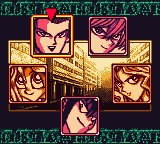
|
| Stage 2 - Domino City | |
|

|
| Stage 3 - Ancient Egypt | |
|
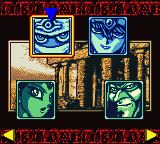
|
| Stage 4 - DarkNite | |

| |
| Stage 5 | |
| |
Starter Deck
The player's Starter Deck consists of the following 40 cards:[1]
- Sinister Serpent x3
- Milus Radiant
- Zone Eater
- Swordsman from a Foreign Land
- Fungi of the Musk
- Shadow Specter x3
- Bone Mouse
- Kaminarikozou
- White Dolphin
- Wretched Ghost of the Attic x2
- Turu-Purun x2
- Jinzo #7
- Muka Muka
- Mech Mole Zombie
- Mechanical Spider
- Boo Koo
- Star Boy
- Abyss Flower
- Mystery Hand x3
- Hiro's Shadow Scout x2
- Air Marmot of Nefariousness
- Droll Bird
- Yamatano Dragon Scroll
- Bladefly
- Frog The Jam
- Gale Dogra
- Masked Clown
- Cyber-Stein
Format
Dark Duel Stories does not totally conform to the rules of the Official Card Game. This includes many cards having different effects, or having their effects removed altogether, including, but not limited to, Jirai Gumo; this means that some Monster cards with effects in the OCG may not have any effects at all in this game, whether positive or negative. Rather than having flip effects or passive effects like many cards in the OCG, most cards seem to only be able to activate their effects on the first turn they are played. Many cards seen only in this game (the 'Creatable' cards) also have Type and/or Attribute that do not match their appearance at all. While this can also be seen in the official card game, this happens much more often in this game.
During gameplay there is more than one way to win. A player may win by decreasing the opponent's life points to zero, forcing your opponent to run out of cards (have them unable to draw a card at the start of their turn), or by having all five pieces of Exodia in your hand.
In order to duel, a player's Deck must contain 40 cards and be under their current Duelist Level. If the Deck is over/under 40 cards or over the Deck limit cost, the player will not be able to duel until the error is fixed.
Here are some basic rules for playing:
- You may only have up to five monsters on the field.
- You may have up to five cards in your hand (Note: If you have five cards in hand at the start of your turn, you will not be able to draw a new card).
- Each Monster Card may attack any opposition monster card on the field.
- Once the field is empty, you may attack the opposing duelist's Life Points.
- Each duelist starts with 8000 Life Points (Life Points).
- In order to summon a 5-6 star Card, you must Tribute one monster that is already on the field.
- In order to summon a 7-8 star Card, you must Tribute two monsters that are already on the field.
- You may only summon one monster per turn.
- You may also set one Trap Card on the field (Note: If the Trap is not used during the opponent's turn, it is removed at the start of your turn).
Battle types
In the game, players may notice a few different types of battle between monster cards.
The most basic way to defeat an opposing monster is to have a monster with higher attack
Example: Player A's card = 1000 ATK, Player B's card = 1200 ATK. Player A's card is destroyed and loses 200 Life Points (Life Points)
However, in Yu-Gi-Oh! Dark Duel Stories monsters can be destroyed because they have an inferior Alignment (which substitutes Attribute in this game). In this format, the difference between Attack or Defense points does not matter and the card with the inferior alignment is instantly destroyed. The exception to this rule is when the monster with the superior alignment also has higher attack points (when attacking) or defense points (when being attacked in defense position), in which case battle damage is calculated normally. However, when a defense position is attacked by a monster with an inferior alignment, the monster with the inferior alignment is destroyed.
Alignment List:
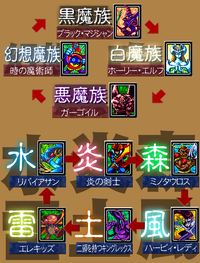
Alignment strengths and weaknesses.
also:
No other type of card or alignment has an advantage over a card that has a Divine (misspelled in-game as Devine) type and alignment. In addition, cards that fall into one alignment list do not have an advantage over cards in the other.
Passwords
In the game, players can go to the Password Mode option. There they can input an 8-digit password found at the bottom of each trading card (sold separately), saving the card into their chest. Players can add saved cards from their chest to their Deck, depending on how many points they have. The more points, the more stronger cards. You get points for winning battles, but you don't lose points for losing.
Téa Gardner also gives you 1 card for every duel that you win. If you type in a special password, Yugi's Grandpa will also appear and give you another card. Téa and Grandpa will also give the player one card part for each win as well. (see "Card Creation" for part information)
There are also hidden passwords that unlock the hidden bosses in STAGE 5 and the Credits. Since STAGE 5 can only have one duelist, once the player inputs a password for a STAGE 5 hidden boss (Yami Yugi, Yami Bakura, Nitemare, Marik, and Shadi), the previous boss in that stage is deleted. But, when you re-enter the password for deleted box, the records are the same (meaning deleted duelist just doesn't appear while there's another duelist in stage 5, but when you re-enter them their old scores reappear. So the data of your previous battles with them are saved and are not erased).
Note: Some cards will not be able to be added with the Password Option. Normally an incorrect password will simply not work, but entering certain card codes, like that of Graceful Charity, will have the game give the alternate message "Can't Record Password! Try a different password." The cards corresponding to these codes were released in the Trading Card Game at the time this video game was made, but were not actually included in Dark Duel Stories itself.
Card creation
It has a unique feature: Players can create cards using different card parts, one for the upper half, and one for the lower half. You cannot make a card unless you have at least one top and one bottom half of a card. The player can also preview the created card before using up his/her parts. The only real catch is that the attack and defense can only go as high as 2000.
Fusion
Since Polymerization is not included in this game, Fusions occur differently; selecting one card and placing it on top of another compatible card could result in a fusion for an entirely different monster.
These Fusions are Alignment-based and are reflected as such in the combination they create. For instance, fusing Thunder Kid with Yamatano Dragon Scroll would result in Thunder Dragon. Similarly, combining it with any number of Aqua monsters would normally result in Bolt Escargot. Also, combining Time Wizard with Baby Dragon would result in Thousand Dragon.
Promotional cards
Japanese
International
Game guides
Gallery
Trivia
- Marik's appearance on the cover of this game is taken from the title page of Yu-Gi-Oh! Duelist Duel 101: "Marik Strikes!".
References
External links
- Official English website (archive)
- Official Japanese website (archive)
- Moby Games page
- Gamefaqs page
- The Cutting Room Floor page
- Data Crystal page
- The Spriters Resource page
- Cards data and drops spreadsheet
| ||||||||||||||||||||||||||||||||||||||||||||||||||||||||||||||||||||||||||
| ||||||||||||||||||||||||||||||||||||||

